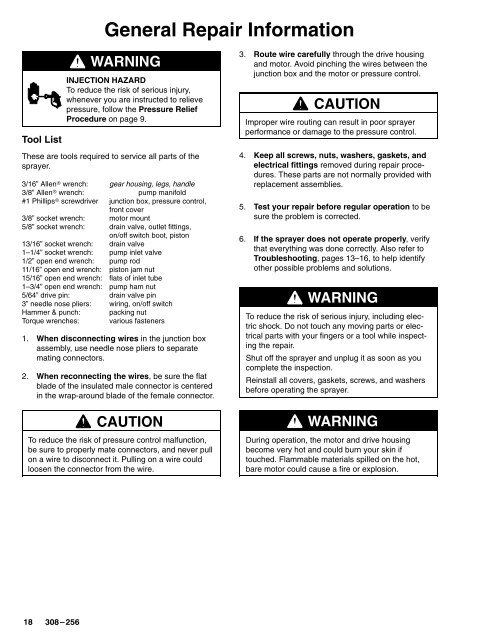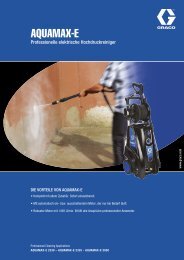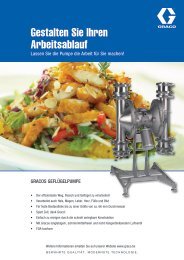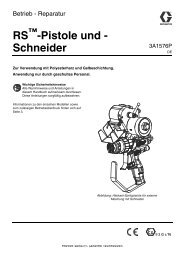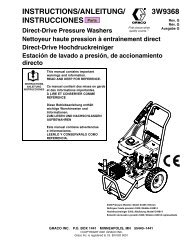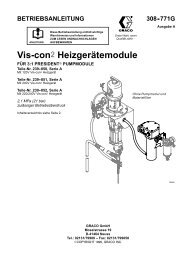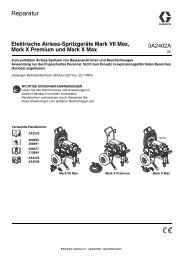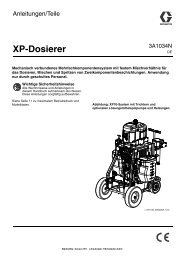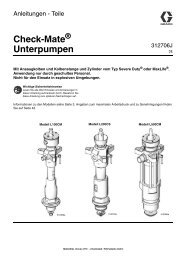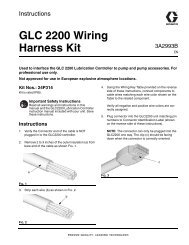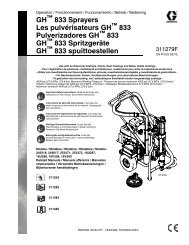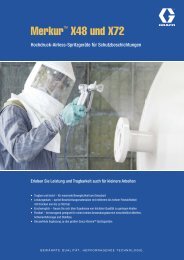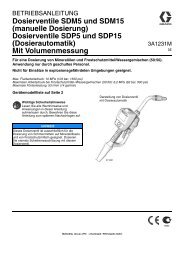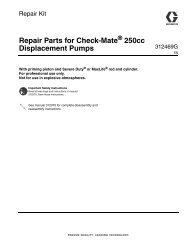Pro 501st Airless Paint Sprayer - Graco Inc.
Pro 501st Airless Paint Sprayer - Graco Inc.
Pro 501st Airless Paint Sprayer - Graco Inc.
You also want an ePaper? Increase the reach of your titles
YUMPU automatically turns print PDFs into web optimized ePapers that Google loves.
General Repair Information<br />
Tool List<br />
WARNING<br />
INJECTION HAZARD<br />
To reduce the risk of serious injury,<br />
whenever you are instructed to relieve<br />
pressure, follow the Pressure Relief<br />
<strong>Pro</strong>cedure on page 9.<br />
These are tools required to service all parts of the<br />
sprayer.<br />
3/16” Allen wrench: gear housing, legs, handle<br />
3/8” Allen wrench: pump manifold<br />
#1 Phillips screwdriver junction box, pressure control,<br />
front cover<br />
3/8” socket wrench: motor mount<br />
5/8” socket wrench: drain valve, outlet fittings,<br />
on/off switch boot, piston<br />
13/16” socket wrench: drain valve<br />
1–1/4” socket wrench: pump inlet valve<br />
1/2” open end wrench: pump rod<br />
11/16” open end wrench: piston jam nut<br />
15/16” open end wrench: flats of inlet tube<br />
1–3/4” open end wrench: pump ham nut<br />
5/64” drive pin: drain valve pin<br />
3” needle nose pliers: wiring, on/off switch<br />
Hammer & punch: packing nut<br />
Torque wrenches: various fasteners<br />
1. When disconnecting wires in the junction box<br />
assembly, use needle nose pliers to separate<br />
mating connectors.<br />
2. When reconnecting the wires, be sure the flat<br />
blade of the insulated male connector is centered<br />
in the wrap-around blade of the female connector.<br />
CAUTION<br />
To reduce the risk of pressure control malfunction,<br />
be sure to properly mate connectors, and never pull<br />
on a wire to disconnect it. Pulling on a wire could<br />
loosen the connector from the wire.<br />
3. Route wire carefully through the drive housing<br />
and motor. Avoid pinching the wires between the<br />
junction box and the motor or pressure control.<br />
CAUTION<br />
Improper wire routing can result in poor sprayer<br />
performance or damage to the pressure control.<br />
4. Keep all screws, nuts, washers, gaskets, and<br />
electrical fittings removed during repair procedures.<br />
These parts are not normally provided with<br />
replacement assemblies.<br />
5. Test your repair before regular operation to be<br />
sure the problem is corrected.<br />
6. If the sprayer does not operate properly, verify<br />
that everything was done correctly. Also refer to<br />
Troubleshooting, pages 13–16, to help identify<br />
other possible problems and solutions.<br />
WARNING<br />
To reduce the risk of serious injury, including electric<br />
shock. Do not touch any moving parts or electrical<br />
parts with your fingers or a tool while inspecting<br />
the repair.<br />
Shut off the sprayer and unplug it as soon as you<br />
complete the inspection.<br />
Reinstall all covers, gaskets, screws, and washers<br />
before operating the sprayer.<br />
WARNING<br />
During operation, the motor and drive housing<br />
become very hot and could burn your skin if<br />
touched. Flammable materials spilled on the hot,<br />
bare motor could cause a fire or explosion.


